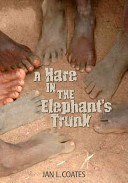
A Hare in the Elephant’s Trunk
Written by Jan L. Coats
Red Deer Press, 2010, 291 pp.
ISBN: 978-08899954519
It was a very bad sign when boys stopped talking. They were often the same boys who gave up, too hungry, too thirsty, and too tired even for one more step. They just sat down and quietly waited to die. (p.80)
Such is the world for seven-year-old Jacob Deng who embarks on a remarkable forced journey spanning several years and miles of evading death in its many forms. A Hare in the Elephant’s Trunk tells the true story of Jacob, a Lost Boy of Sudan, who was forced to roam the country in search of a place to call home that offers freedom from fear and death. Thousands of Lost Boys are fleeing the brutal civil war that has locked the country in a vice of terror, displacement, and separation from families. Coats’ lyrical imagery woven throughout the book describes the war as “spreading across Southern Sudan like a hungry grass fire” (p.19). It consumes livelihoods and lives in its path and leaves survivors struggling to make sense of it all as they seek to rebuild their world without the support of family, shelter and security. Jacob flees his village with his older nephew when it is attacked. He does not know the fate of his mother and sisters. Almost immediately, he must cease to be a boy and begin to shoulder the responsibilities of someone much older.
Selected as a 2011 Outstanding International Book by the United States Board on Books for Young People (USBBY), A Hare in the Elephant’s Trunk offers readers a unique look into the physical and mental journey of boys turned into men too soon. Readers will connect to the indomitable spirit and strength of Jacob and the other Lost Boys. Like many of the Lost Boys, Jacob lived in a communal home in southern Sudan steeped in tradition and family. Suddenly, violently, his world becomes surreal and unrecognizable as “great hungry gray monsters came growling into the village from the forest, eating up huts and people, their great trunks glowing red as they snorted out their exploding firebombs.” (p. 36) Coats’ ability to turn an armed and blood-soaked invasion into a beautifully haunting account of events as seen through the eyes of a child is indicative of the writing in this book. To a child bereft of any concept of guns or bombs, the tanks that roll into Jacob’s village in the middle of night would be seen as a living breathing monster. These descriptions and others peppered throughout the book act as a salve for the mental wounds that the horrific events in Jacob’s life create for the reader. We still feel the impact but are protected enough to be able to continue the story.
Jacob and his nephew join the Lost Boys in their forced journey on the way to the safety of Ethiopia. They endure day after day, step after step of merciless walking in a vague direction. In the midst of the maleness, Jacob misses his mother. All of the boys do. When they share stories of home, it is usually a memory of mother. When lions attack in the middle of the night, it is “Mama!” the boys ineffectually cry out to save them. Jacob believes with all of his child naïveté, he will find his mother. A stone given to him by her shortly before the invasion buttresses this belief. She told him he should touch the stone to connect to her regardless of where she is. The stone serves as a reminder to Jacob of his mother’s fervent desire for him to pursue an education. This reminder becomes a personal schism as he wrestles making a choice between education and becoming a soldier to protect his country. It may seem that A Hare in the Elephant’s Trunk is rife with misery and suffering yet it is primarily a story about the power of perseverance and reward for resilience. The focus is on how Jacob copes and overcomes each setback, disappointment and random brush with death. In the face of overwhelming odds against his survival, Jacob retains the principles his mother has taught him and thrives.
Other relevant books to pair with this novel include Year of No Rain (Alice Mead, 2003), The Lost Boys of Natinga (Judy Walgren, 1998) and Warchild (Emmanuel Jal, 2009). Coats is a Nova Scotian author who has written over a dozen children’s books and received several awards and recognition for her work including the 2011 Publisher Book Award Silver medalist and the 2011 Skipping Stones Honor Award for this novel. She was inspired to write this story after meeting Jacob Deng who was a university student in Nova Scotia at the time he related his story. She says that the book “is a work of fiction inspired by his true story” (http://www.cbc.ca/news/arts/story/2011/10/24/hare-in-the-elephants-trunk.html). Interviews with Coats and Jacob Deng are included as an afterward and attest to the book’s cultural authenticity.
Breshaun-B. Joyner, University of New Mexico, Albuquerque, NM
WOW Review, Volume IV, Issue 2 by Worlds of Words is licensed under a Creative Commons Attribution-NonCommercial-ShareAlike 4.0 International License. Based on work at https://wowlit.org/on-line-publications/review/iv-2/

I hadn’t read this review before; thank you so much for appreciating the essence of Jacob’s story.
Thank you. We’re glad you found it! Our goal with WOW Review is to make global literature more visible so we are thrilled it “worked” and you found the review insightful.
Susan Corapi & Prisca Martens, Co-Editors, WOW Review